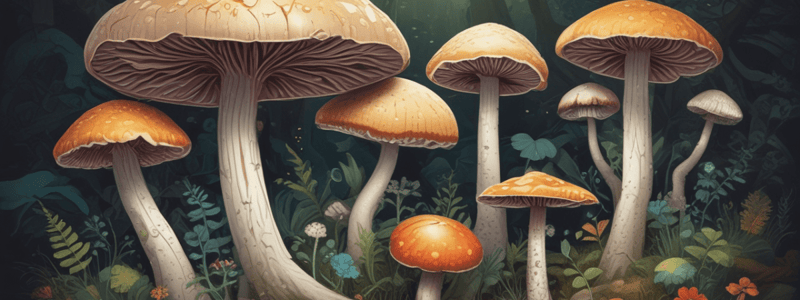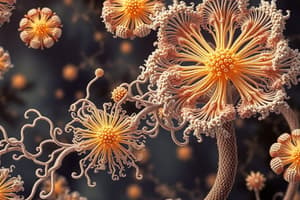Podcast
Questions and Answers
What is the term used to describe the study of fungi?
What is the term used to describe the study of fungi?
Mycology
How do fungi obtain nutrients?
How do fungi obtain nutrients?
- By ingesting other organisms
- By secreting enzymes and absorbing nutrients (correct)
- Through photosynthesis
Fungal cell walls are made of chitin, which is a polymer of ______.
Fungal cell walls are made of chitin, which is a polymer of ______.
N-acetylglucosamine
Without fungi, dead plants and trees would not decompose.
Without fungi, dead plants and trees would not decompose.
Match the Fungal Subclass with its description:
Match the Fungal Subclass with its description:
What is the primary usage of Tempeh?
What is the primary usage of Tempeh?
Which organism causes Rice Seedling Blight?
Which organism causes Rice Seedling Blight?
Histoplasmosis is caused by Histoplasma capsulatum.
Histoplasmosis is caused by Histoplasma capsulatum.
What pathogen causes White Nose Syndrome in bats? ______ is an insect pathogen that infects the skin of hibernating bats on a large scale.
What pathogen causes White Nose Syndrome in bats? ______ is an insect pathogen that infects the skin of hibernating bats on a large scale.
What is the primary virulence factor of Cryptococcus neoformans?
What is the primary virulence factor of Cryptococcus neoformans?
What type of fungi is Rhizopus and what is its common name?
What type of fungi is Rhizopus and what is its common name?
What does Tempeh come from?
What does Tempeh come from?
Rhizopus toxin causes Rice Seedling Blight. (True/False)
Rhizopus toxin causes Rice Seedling Blight. (True/False)
Which type of fungi is known for producing yeast in human macrophages?
Which type of fungi is known for producing yeast in human macrophages?
What is the domain of fungi?
What is the domain of fungi?
What is the kingdom of fungi?
What is the kingdom of fungi?
What is the size range of fungi?
What is the size range of fungi?
What is unique about the cell walls of fungi?
What is unique about the cell walls of fungi?
What type of nutrition do fungi exhibit?
What type of nutrition do fungi exhibit?
What is the significance of fungi in the ecosystem?
What is the significance of fungi in the ecosystem?
What is the study of fungi called?
What is the study of fungi called?
What is a mycosis?
What is a mycosis?
What are aflatoxins?
What are aflatoxins?
Where are fungi typically found?
Where are fungi typically found?
What is the relationship between mycorrhizal fungi and plants?
What is the relationship between mycorrhizal fungi and plants?
What is the difference between yeasts and molds?
What is the difference between yeasts and molds?
What is the function of Candida albicans?
What is the function of Candida albicans?
What is the difference between aseptate and septate hyphae?
What is the difference between aseptate and septate hyphae?
What is the significance of fungal sexual reproduction?
What is the significance of fungal sexual reproduction?
What is a dikaryon?
What is a dikaryon?
What is the role of pheromones in fungal sexual reproduction?
What is the role of pheromones in fungal sexual reproduction?
What are the four main subclasses of fungi?
What are the four main subclasses of fungi?
Flashcards are hidden until you start studying
Study Notes
Fungi General Features
- Fungi belong to the domain Eukarya and kingdom Fungi.
- They range in size from single-celled yeast to 3-mile-wide honey mushrooms.
- Fungi lack chlorophyll and have cell walls made of chitin (a polymer of N-acetylglucosamine).
- They have absorptive nutrition, secreting enzymes to break down nutrients.
- Fungi are essential decomposers, breaking down complex organic compounds like cellulose.
- Without fungi, dead plants and trees would accumulate, and plant and human life would cease.
Fungi Terms
- Mycology is the study of fungi.
- Mycoses are diseases caused by fungi.
- Mycotoxicosis is poisoning by fungal toxins, such as aflatoxins, which are carcinogens.
Fungi Distribution
- Fungi are mostly terrestrial, but some are aquatic.
- They can be part of human microflora and can form associations with other organisms, like lichens (fungi and cyanobacteria) and mycorrhizal fungi and plants.
- Examples of mycorrhizal fungi and plants include truffles.
Yeasts and Molds
- Yeasts are unicellular fungi, such as Saccharomyces cerevisiae (used in bread, beer, and wine) and Candida albicans (found in the mouth, vagina, and intestinal tract).
- Molds are multicellular fungi, such as Aspergillus, with hyphae (filaments) and mycelium (a mass of hyphae).
- Some fungi can change from yeast to mold form, known as the yeast-mold shift.
Fungi Reproduction
- Asexual reproduction involves binary fission, budding, and spore production, resulting in offspring genetically identical to the parent.
- Sexual reproduction involves the fusion of haploid cells of opposite mating types, resulting in a diploid zygote that undergoes meiosis to form haploid spores.
Fungi Subclasses
- Chytridiomycetes are simple fungi with motile flagellated zoospores, often found in aquatic environments.
- Zygomycetes (Mucormycota) have sexual zygospores and asexual sporangiospores, and include species like Rhizopus (used in meat tenderizer and birth control agents).
- Ascomycota (sac fungi) produce sexual ascospores and asexual conidiospores, and include species like Aspergillus and Penicillium.
- Basidiomycota (club fungi) produce sexual basidiospores and include species like mushrooms and Cryptococcus neoformans (a pathogen in immunocompromised individuals).
Fruiting Bodies and Spores
- Fruiting bodies, like mushrooms, produce spores for reproduction.
- Ascomycota produce asci, containing sexual ascospores, while Basidiomycota produce basidia, bearing sexual basidiospores.
- Examples of Basidiomycota include edible mushrooms (Agaricus) and deadly species like Amanita (containing the toxin Amanitin).
Fungi General Features
- Fungi belong to the domain Eukarya and kingdom Fungi.
- They range in size from single-celled yeast to 3-mile-wide honey mushrooms.
- Fungi lack chlorophyll and have cell walls made of chitin (a polymer of N-acetylglucosamine).
- They have absorptive nutrition, secreting enzymes to break down nutrients.
- Fungi are essential decomposers, breaking down complex organic compounds like cellulose.
- Without fungi, dead plants and trees would accumulate, and plant and human life would cease.
Fungi Terms
- Mycology is the study of fungi.
- Mycoses are diseases caused by fungi.
- Mycotoxicosis is poisoning by fungal toxins, such as aflatoxins, which are carcinogens.
Fungi Distribution
- Fungi are mostly terrestrial, but some are aquatic.
- They can be part of human microflora and can form associations with other organisms, like lichens (fungi and cyanobacteria) and mycorrhizal fungi and plants.
- Examples of mycorrhizal fungi and plants include truffles.
Yeasts and Molds
- Yeasts are unicellular fungi, such as Saccharomyces cerevisiae (used in bread, beer, and wine) and Candida albicans (found in the mouth, vagina, and intestinal tract).
- Molds are multicellular fungi, such as Aspergillus, with hyphae (filaments) and mycelium (a mass of hyphae).
- Some fungi can change from yeast to mold form, known as the yeast-mold shift.
Fungi Reproduction
- Asexual reproduction involves binary fission, budding, and spore production, resulting in offspring genetically identical to the parent.
- Sexual reproduction involves the fusion of haploid cells of opposite mating types, resulting in a diploid zygote that undergoes meiosis to form haploid spores.
Fungi Subclasses
- Chytridiomycetes are simple fungi with motile flagellated zoospores, often found in aquatic environments.
- Zygomycetes (Mucormycota) have sexual zygospores and asexual sporangiospores, and include species like Rhizopus (used in meat tenderizer and birth control agents).
- Ascomycota (sac fungi) produce sexual ascospores and asexual conidiospores, and include species like Aspergillus and Penicillium.
- Basidiomycota (club fungi) produce sexual basidiospores and include species like mushrooms and Cryptococcus neoformans (a pathogen in immunocompromised individuals).
Fruiting Bodies and Spores
- Fruiting bodies, like mushrooms, produce spores for reproduction.
- Ascomycota produce asci, containing sexual ascospores, while Basidiomycota produce basidia, bearing sexual basidiospores.
- Examples of Basidiomycota include edible mushrooms (Agaricus) and deadly species like Amanita (containing the toxin Amanitin).
Studying That Suits You
Use AI to generate personalized quizzes and flashcards to suit your learning preferences.




